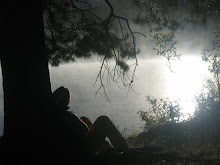So why am I opening a post about botulism with this story? Because last week, when the mattress was happily offgasing itself in the hallway outside my bedroom and wafting its friendly chemicals into my sleep, I awoke in the middle of the night with a sore throat, pain in my sides and back, a stuffy nose, nausea, and mental confusion. And I thought to myself, "Oh nooo, I have botulism! I am going to die now. I want my mommy." I didn't die (mattress chemicals are slower to kill you than botulism, I hear.) My symptoms went away upon covering the mattress with the plastic wrap.
However, it's holiday season, and people are wrapping other, more pleasant items and gifting and re-gifting left and right. I received a re-gift of some home-canned, pickled fruit. I am not including a picture in case, by some rare chance, the original gifter stumbles across this blog. But I will say that it was slightly discolored at the top and so, although the source was a highly reliable and experienced canner, there was some speculation about the safety factor. Being ignorant and cocky, I ate it anyway. It was very tasty. That was on Dec 23, so I have until New Years Day to see if I'm going to live.
Here's the thing about botulism: if it's there, you can't tell. It's a silent killer. You can't smell it. You can't see it. You can't taste it. And it can take up to eight days for you to exhibit any symptoms of your impending death if you happen to come into contact with it. It is a rare danger, but a real danger. And if you are involved in a serious way in the local foods movement, you are likely to take a foray into the world of canning at some point. So, here's what you need to know:
1. Botulism bacteria is anaerobic. This means that the sealed environment of a jar is perfect for it. This also means that exposure to open-air cooking with frequent stirring on high heat for at least 15 minutes will kill it dead.
2. Botulism bacteria spores can survive boiling temperatures (212 degrees), so simply boiling the food BEFORE you can it does NOT guarantee safety.
3. Don't can food that looks rotten to start with.
4. Don't do a botulism taste-test...you can't taste it, and it can kill you anyway.
5. Low-acid and low-sugar foods are more susceptible to the toxin, but that doesn't guarantee the safety of the high-acid, high-sugar foods.
6. Pressure canning creates a high-enough heat (240 degrees) to destroy the botulism bacteria, so if in doubt, pressure can.
Botulism is rare, and the fact that what I ate was both sugary (fruit) and acidic (pickled) means that I'm probably in the clear. But it occurs to me that, with the local foods movement catching on and lots of enthusiastic amateurs taking up the practice of food preservation, it's important to keep the sobering facts in mind.
If you don't hear from me after New Years, just think of me whenever you can something (correctly) in the future.
My sources:
The Encyclopedia of Country Living
Joy of Cooking: 75th Anniversary Edition - 2006
http://www.webmd.com/a-to-z-guides/botulism-10381




 I baked them 50 minutes on 375 as recommended, but next time I would likely cover them for the second half of the bake time to protect from burning. The end result was was rich and brothy. I might like to add another vegetable to the filling...maybe mashed sweet potatoes? Or something spicy? In any case, I have a jar of them in the freezer to test how useful they may be as a sort of "local fast-food" in the future.
I baked them 50 minutes on 375 as recommended, but next time I would likely cover them for the second half of the bake time to protect from burning. The end result was was rich and brothy. I might like to add another vegetable to the filling...maybe mashed sweet potatoes? Or something spicy? In any case, I have a jar of them in the freezer to test how useful they may be as a sort of "local fast-food" in the future. 





































